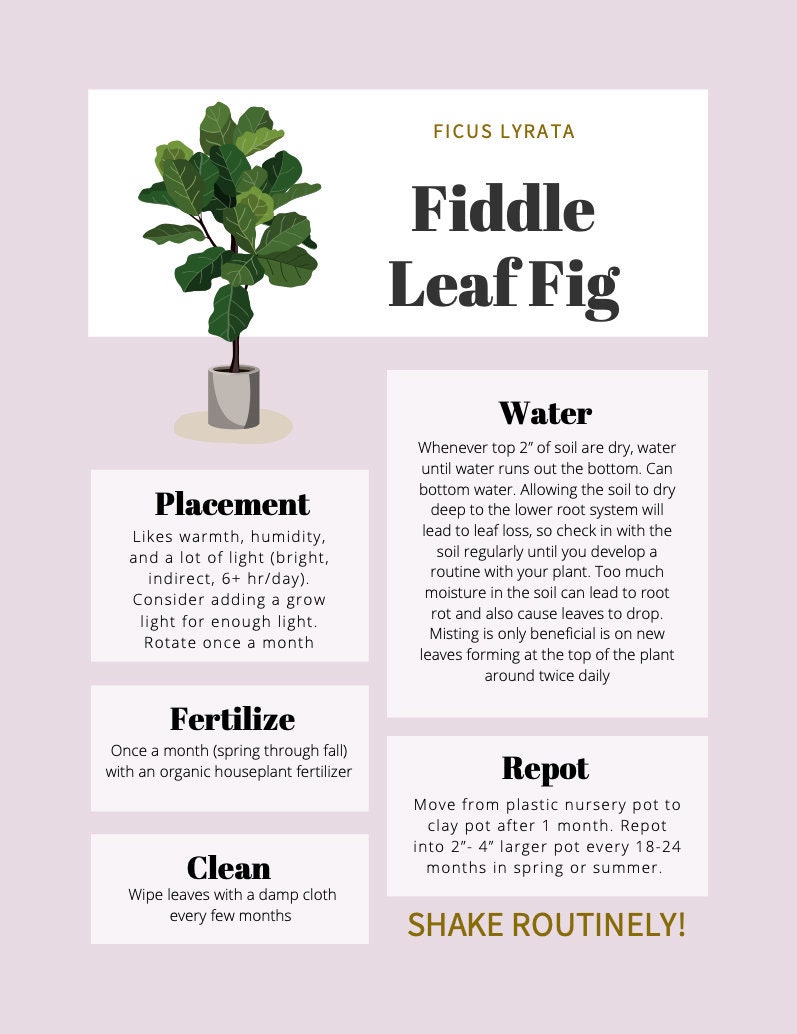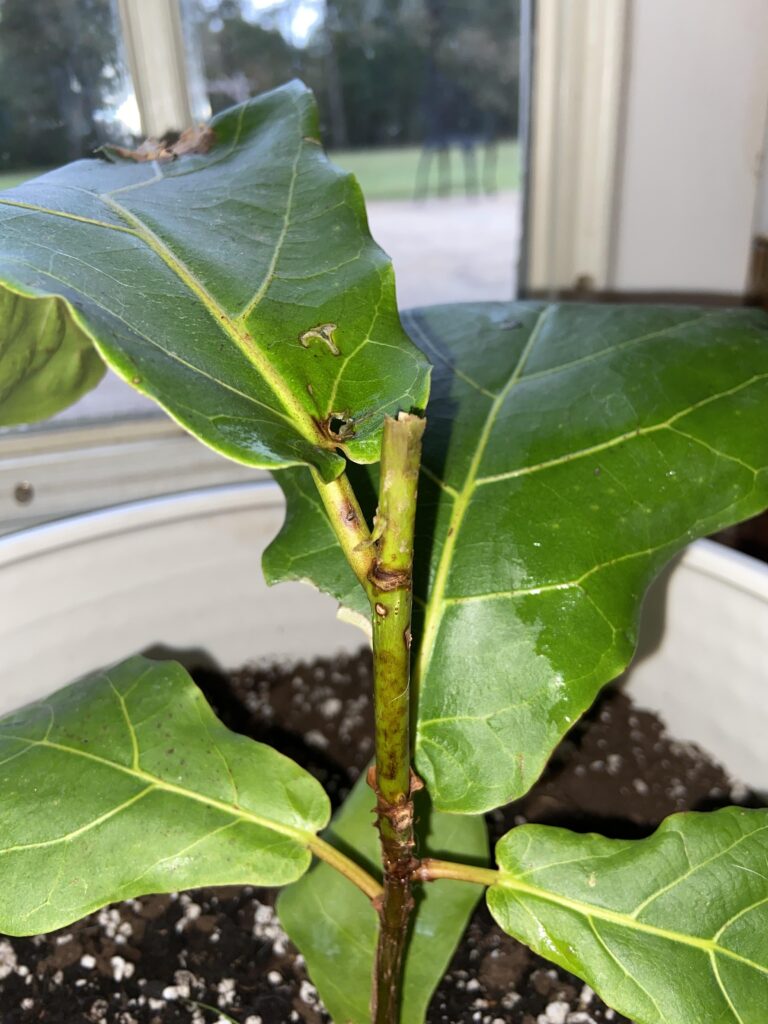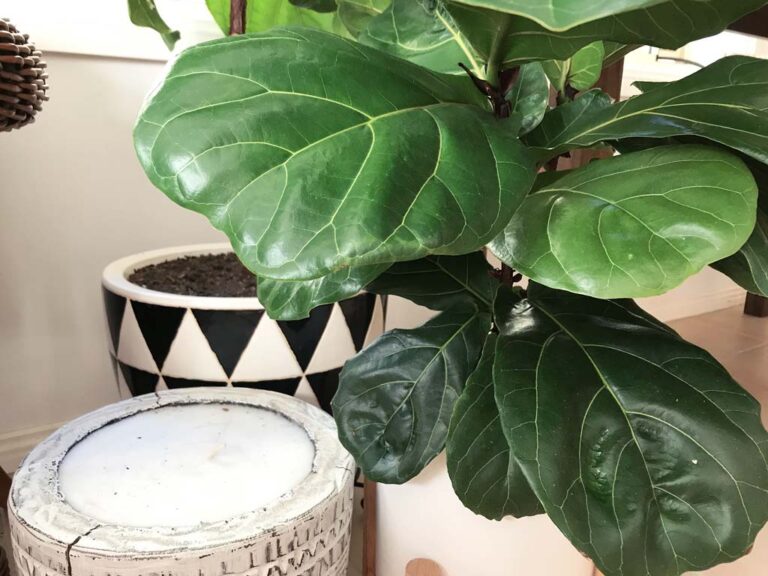Watering Essentials for Indoor Plants
Proper watering techniques are fundamental for the healthy growth of a fiddle leaf fig tree. Understanding the signs of underwatering vs. overwatering and the importance of consistent watering can prevent common issues and promote thriving plants.
Signs of Underwatering vs. Overwatering
Recognizing the symptoms of improper watering is crucial for maintaining the health of your indoor plants, especially fiddle leaf figs.
Underwatering Symptoms:
- Curled leaves
- Brown spots on leaf edges
- Brown spots appearing all over the plant, especially on otherwise healthy leaves (Leon and George)
Overwatering Symptoms:
- Brown spots near the center and edges of leaves
- Multiple yellow spots
- General browning with dark spots or shady areas
- Tendency to drop bottom leaves due to root rot (Leon and George)
| Symptom | Underwatering | Overwatering |
|---|---|---|
| Curled leaves | Yes | No |
| Brown spots on edges | Yes | Yes |
| Yellow spots | No | Yes |
| Browning with dark spots | No | Yes |
| Leaves dropping from bottom | No | Yes |
| Brown spots throughout | Yes | No |
Importance of Consistent Watering
Maintaining a consistent watering schedule is vital for the health of your fiddle leaf fig tree. Inconsistent watering can lead to symptoms of both under- and overwatering, making it challenging to diagnose and address issues (Leon and George). Establishing a routine helps ensure that the roots dry out adequately between waterings, preventing the soil from becoming waterlogged or excessively dry.
To practice consistent watering:
- Water your plant at the same time each week.
- Use a moisture meter to accurately assess soil moisture levels.
- Adjust watering frequency based on seasonal changes and environmental factors.
Ensuring consistent watering is essential for a fiddle leaf fig’s health, preventing root rot and promoting robust growth (fiddle leaf fig growth rate). For more tips on keeping your fiddle leaf fig thriving, you can explore our detailed guides on fiddle leaf fig tree fertilizer and fiddle leaf fig plant light.
Establishing a Watering Routine
Creating a watering routine is essential for maintaining the health of your fiddle leaf fig tree. Regular and consistent watering schedules ensure that the roots have enough time to dry out between waterings, which prevents both overwatering and underwatering (Leon and George). Below, we will discuss the optimal watering frequency and how to use a moisture meter to maintain your plant’s well-being.
Optimal Watering Frequency
For a thriving fiddle leaf fig tree, a moderate and consistent watering schedule is key. It is recommended to water your plant once every 7 to 10 days. By adhering to this schedule, you can prevent issues related to either overwatering or underwatering.
| Watering Frequency | Recommendation |
|---|---|
| Watering Interval | Every 7 to 10 days |
| Avoidance | Prevent soil from drying out completely |
| Consistency | Maintain a regular watering routine |
(Fiddle Leaf Fig Plant Resource)
Ensuring that the soil does not dry out completely is crucial to avoid soil shrinkage, which can lead to root issues and overall plant stress. Consistently following a moderate watering schedule can help prevent erratic watering patterns that could harm your plant.
Using a Moisture Meter
To accurately monitor the moisture levels in the soil of your fiddle leaf fig tree, using a moisture meter is highly recommended. This tool can help you identify whether the plant is being overwatered or underwatered, thus allowing you to adjust your watering routine accordingly.
Here’s how to effectively use a moisture meter:
- Insert the Probe: Push the moisture meter probe into the soil near the roots of your fiddle leaf fig tree.
- Read the Levels: Check the reading on the meter, which usually ranges from dry (1) to wet (10).
- Adjust Watering: If the meter shows a dry reading (1-3), it’s time to water. A reading in the moist range (4-7) indicates the soil has adequate moisture. If the reading is in the wet range (8-10), allow the soil to dry out before the next watering.
| Meter Reading | Action |
|---|---|
| 1-3 (Dry) | Water the plant |
| 4-7 (Moist) | No action needed |
| 8-10 (Wet) | Wait before watering |
Using a moisture meter can provide better control over your watering routine, helping your fiddle leaf fig tree flourish. For more insights, you can visit our detailed guide on fiddle leaf fig tree care.
By establishing a proper watering routine and regularly monitoring soil moisture levels, you can ensure the health and vitality of your fiddle leaf fig tree.
Watering Techniques for Fiddle Leaf Figs
Proper watering techniques are essential for maintaining the health and vibrancy of your fiddle leaf fig. In this section, we’ll discuss methods for monitoring soil moisture and adjusting watering based on seasonal factors.
Monitoring Soil Moisture
Monitoring the soil moisture is crucial to ensure your fiddle leaf fig receives the right amount of water. Overwatering or underwatering can lead to serious plant issues, including root rot or dehydration. Using a moisture meter can help you accurately check the moisture levels in the plant’s roots, aiding in adjusting the watering routine (Leon and George).
| Moisture Level | Action Required |
|---|---|
| Dry (0-2) | Water the plant |
| Moist (3-7) | No action needed |
| Wet (8-10) | Hold off on watering |
For a thriving fiddle leaf fig, it is recommended to water it once every 7 to 10 days. Consistent and moderate watering prevents the issues associated with erratic watering schedules (Lively Root).
Adjusting Based on Seasonal Factors
The water needs of a fiddle leaf fig may vary depending on factors like light conditions, climate, humidity, temperature, and pot size (Lively Root). By adjusting the watering frequency based on these elements, you can ensure your plant remains healthy throughout the year.
| Season | Watering Frequency | External Factors |
|---|---|---|
| Spring | Every 7-10 days | Increased sunlight and growth |
| Summer | Every 5-7 days | Higher temperatures and humidity |
| Fall | Every 10-14 days | Reduced growth and cooler temperatures |
| Winter | Every 14-20 days | Dormant stage and lower light levels |
Overwatering during colder months can lead to waterlogged soil and root rot, whereas underwatering in summer can cause the soil to dry out too quickly. Always adjust the watering schedule based on how quickly the soil dries out between waterings (Lively Root).
By following these watering techniques, you’ll be better equipped to nurture your fiddle leaf fig. For more detailed tips, visit our sections on fiddle leaf fig plant light and fiddle leaf fig root rot.
Watering Tips for Thriving Plants
Proper watering is vital for the health of your fiddle leaf fig tree. This section explores the importance of water type and external factors that can influence your watering routine.
Choosing the Right Water Type
The type of water used for your fiddle leaf fig tree can significantly impact its health. Tap water, while convenient, may contain chlorine, fluoride, and other chemicals that aren’t ideal for sensitive plants. Here are some recommended water types:
- Filtered Water: Removes most impurities, making it a safe option.
- Rainwater: Naturally soft and free from chemicals.
- Distilled Water: Free of minerals, ensuring no buildup in the soil.
Using the right water type ensures your fiddle leaf fig doesn’t absorb harmful substances, promoting healthy growth. For further details on maintaining your plant, check out our article on fiddle leaf fig care.
Understanding External Factors
Various external factors influence the watering schedule of a fiddle leaf fig tree. Adjusting your routine based on these can help meet your plant’s water needs:
| Factor | Influence on Watering |
|---|---|
| Light Conditions | More light increases evaporation; more frequent watering needed |
| Climate | Dry climates require more water; humid climates require less |
| Humidity | Higher humidity reduces evaporation, needing less frequent watering |
| Temperature | Higher temperatures increase water loss through evaporation |
| Seasonal Changes | Growth slows in winter; less water needed |
| Pot Size | Larger pots retain water longer, reducing the watering frequency |
Factors such as light, climate, and pot size can have considerable effects on the moisture requirements of your plant (Lively Root). Use a moisture meter to check the soil moisture before watering to avoid over or underwatering.
To learn more about how to adjust your watering routine based on external factors, visit our guide on fiddle leaf fig problems.




